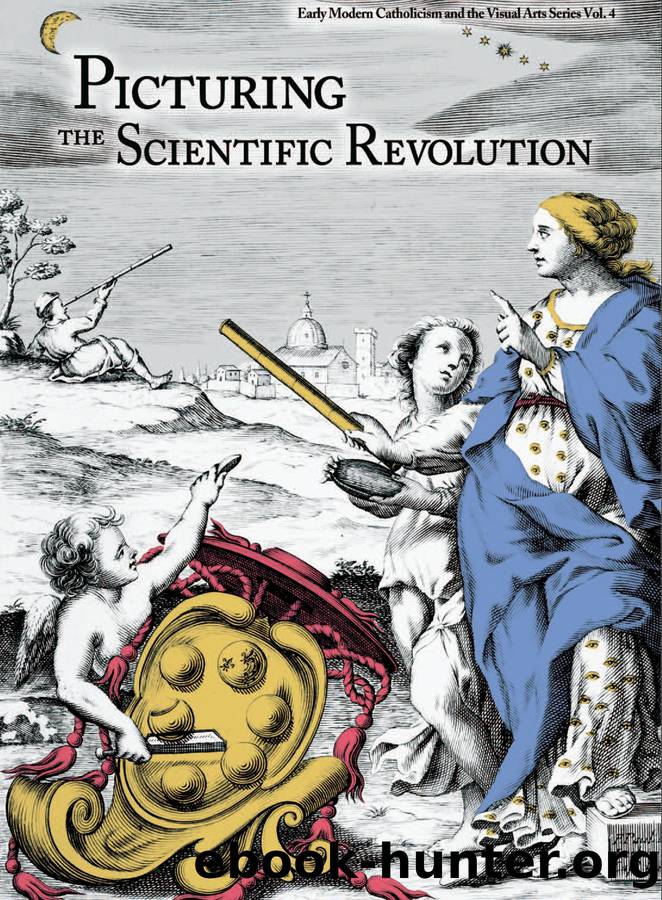Picturing the Scientific Revolution by Remmert Volker;

Author:Remmert, Volker; [Remmert, Volker R.]
Language: eng
Format: epub
Tags: ART035000 ART / Subjects and Themes / Religious, SCI034000 SCIENCE / History
Publisher: Saint Joseph's University Press
5.15 Brahe. Epistolarum Astronomicarum Libri. 1596. Portrait of Brahe by Jacques de Gheyn, detail: Braheâs nose.
5.16 Bayer. Uranometria. 1603. Engraved title page, detail: Herculesâ nose.
In the engraved title page of the Uranometria, Bayer chose to give Hercules Braheâs characteristic nose as a sign that Hercules, the representative of the new astronomy, stood for Brahe [fig. 5.16]. It could be argued that the noses of Hercules and Brahe happened to be similar by coincidence, or due to a quirk of the engraving or a lack of artistic skill; but that seems unlikely, not only on artistic groundsâthe drawing is too skillfully done to allow for a graphical error of this kind, especially on such a prominent feature of its subjectâbut also because in these types of symbol-ridden depictions, the identification of Brahe with Hercules would be known and easily recognized. Such an interpretation of the engraved title page of Uranometria provides impressive evidence of the success of Braheâs self-fashioning and also of the general appeal of personifying the old and the new astronomy with images associated with Atlas and Hercules. Who was assigned the role of who in such images varied according to the subject being depicted and the current interpretational trends. For example, the way the title engravings of works by Andrea Argoli (1570-1657) changed over time illustrates this point.
The life of Argoli has been only sketchily documented, but he was one of the more prominent and prolific of the Italian astronomers and astrologers of the first half of the 17th century. His reputation among his contemporaries rested both on his astrological writings, which were especially concerned with the use of astrology in medicine, and on his ephemerides, which won him the esteem of posterity. Although he was initially heavily influenced by Brahe, he later broke with the Tychonic system and from 1629, if not earlier, promoted his own model of the universe, inspired by Martianus Capella, in which Mercury and Venus orbit the Sun, while Mars, Jupiter, Saturn and the Sun orbit the Earth.80
This development was reflected in the title engravings of Argoliâs publications from 1610 on, in which Atlas-Hercules symbolism is used repeatedly. The engraved title page of his Tabulae Primi Mobilis, published in Rome by Facciotti in 1610, draws a great deal from the engraved title page of Bayerâs Uranometria and in particular from the Brahe Atlas-Hercules association [fig. 5.17]. The figures of Atlas and Hercules have been copied along with the inscriptions that explain the teacher-disciple relationship; and Braheâs nose is likewise replicated on Herculesâ features. The tympanum and pedestal were modified so as to be a eulogy to Marcantonio Colonna (1535â1584) who had led the papal fleet in the much-glorified battle of Lepanto in 1571, and whose descendant, Marcantonio Colonna IV (d. 1611) the Tabulae Primi Mobilis was dedicated to.81
Almost thirty years later, a heavy tome by Argoli on the use of the mathematical sciences in medicine was published under the title De Diebus Criticis et de Aegrorum decubitu libri duo in Padua in 1639.
Download
This site does not store any files on its server. We only index and link to content provided by other sites. Please contact the content providers to delete copyright contents if any and email us, we'll remove relevant links or contents immediately.
Wonder by R.J. Palacio(7750)
Unlabel: Selling You Without Selling Out by Marc Ecko(2989)
POP by Steven Heller(2888)
Hidden Persuasion: 33 psychological influence techniques in advertising by Marc Andrews & Matthijs van Leeuwen & Rick van Baaren(2788)
The Pixar Touch by David A. Price(2744)
Ogilvy on Advertising by David Ogilvy(2695)
Drawing Cutting Edge Anatomy by Christopher Hart(2684)
Slugfest by Reed Tucker(2424)
The Art of War Visualized by Jessica Hagy(2417)
The Curated Closet by Anuschka Rees(2393)
Stacked Decks by The Rotenberg Collection(2283)
365 Days of Wonder by R.J. Palacio(2247)
The Wardrobe Wakeup by Lois Joy Johnson(2238)
The Code Book by Simon Singh(2218)
Rapid Viz: A New Method for the Rapid Visualization of Ideas by Kurt Hanks & Larry Belliston(2200)
Tell Me More by Kelly Corrigan(2200)
Keep Going by Austin Kleon(2170)
Tattoo Art by Doralba Picerno(2087)
Tokyo Geek's Guide: Manga, Anime, Gaming, Cosplay, Toys, Idols & More - The Ultimate Guide to Japan's Otaku Culture by Simone Gianni(1952)
